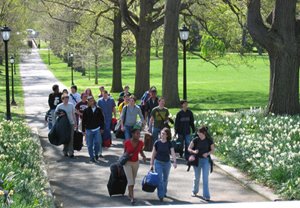Swarthmore Admits Class of 2011 from Record Pool of Applicants
Contact: Nancy Nicely
610-328-8534
nnicely1@swarthmore.edu
Swarthmore Admits 890 Students to Class of 2011
Seventeen Percent Accepted from Record Pool of 5,244 Applications
 |
|
The 5,244 applications represent an eight percent increase over last year's total and a 40 percent increase over three years ago. James Bock '90, dean of admissions and financial aid, attributed the record number of applications to increased outreach by the Admissions Office, Swarthmore's generous need-based financial aid policies, the relative ease of applying to college on-line, demographic changes that are putting more 18-year-olds in the college pipeline, and the tendency among some aspiring college students to apply to a larger number of schools than in the past.
Financial aid is another factor -- about one third of Swarthmore's student body is not asked to borrow. "Many more students are beginning to recognize Swarthmore's long-standing commitment to need-based financial aid," Bock continued. "Historically, we have been concerned about families with moderate incomes and their ability to pay full tuition costs. We have held loans constant over many years. The families of incoming students, many who are first-generation college students and whose incomes and abilities to contribute are limited, are not asked to borrow at all. We are always exploring ways to make a selective college education more affordable for all students."
Of the admitted students who come from high schools that report class rank, 33 percent are valedictorians or salutatorians. Fifty-seven percent are in the top two percent of their high school class, and 92 percent are in the top decile.
The admitted students come from six continents, 32 nations, and 48 U.S. states, as well as the District of Columbia, Puerto Rico, and the Virgin Islands. New York, the home state of 13 percent of the accepted students, is the most represented state in the newly admitted class. California is next with 12 percent. Following, in order, are Pennsylvania, New Jersey, Massachusetts, Maryland, Texas, Virginia, Florida, Washington, Illinois, and Connecticut.
South Korea, with seventeen students, is the most common country of residence among international students in the admitted class. Four each are from India, Pakistan, and the United Kingdom. Three each are from Hong Kong, Japan, China, and Turkey. Two each are from Canada, South Africa, and Venezuela. One each is from Australia, Bangladesh, Brazil, Cayman Islands, Colombia, Denmark, Dominican Republic, El Salvador, Germany, Ghana, Israel, Jamaica, Malaysia, Nepal, Norway, Palestine, Philippines, Singapore, St. Kitts, Taiwan, and Vietnam.
Sixty-one percent of the admitted students come from public high schools, 27 percent from private independent schools, seven percent from parochial schools, five percent from schools overseas, and four are home-schooled. Continuing the trend of recent years, more of the admitted students declare "undecided" as their intended major than any other. Next, in order, are engineering, biology, political science, economics, English, history, and math.
Fifty-three percent of all accepted students identify themselves as domestic students of color. Asian Americans make up 22 percent of the admitted class; African Americans, 15 percent; and Latino/a students, 15 percent. One percent is in the category Native American/Hawaiian.


